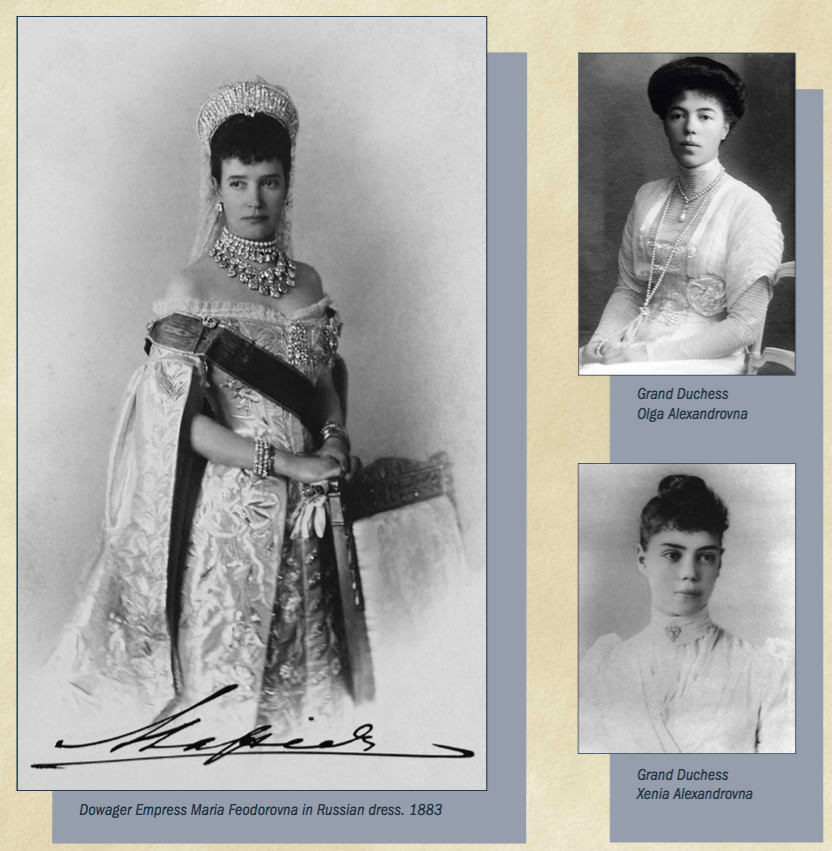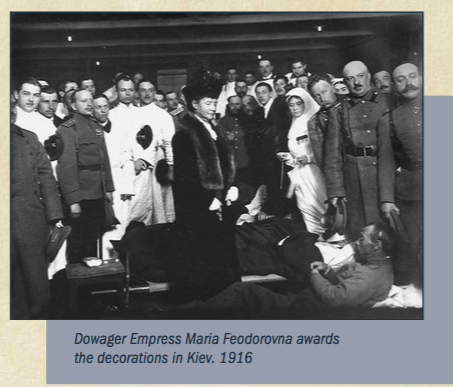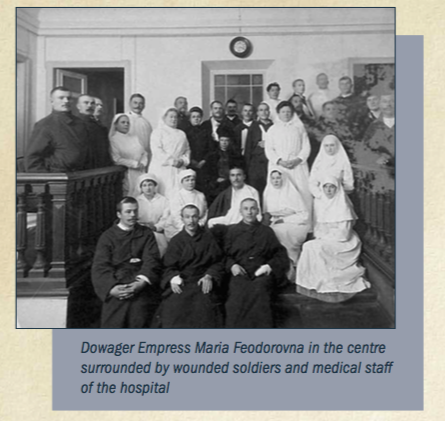THE ROMANOV FAMILY
This page contains selected materials from our exhibition “Imperial House of Romanovs in the First World War”.
EMPRESS MARIA FEODOROVNA

The First World War found the Dowager Empress Maria Fyodorovna in England but by the 27th July 1914 she was back in Russia and immediately showed remarkable energy in organising care for the wounded and in establishing hospitals and warehouses with clothes and medicines.
In August 1914 Maria Feodorovna visited the St. George’s and St Eugene’s Sisters of Mercy to address those who were to go to the front-line hospitals, among whom was her own daughter, Grand Duchess Olga Alexandrovna. Together with her other daughter Xenia, she visited the wounded officers at the Annunciation Hospital.
The Dowager Empress participated in meetings with the President of the Russian Red Cross Society (of which she was patron), A.A. Ilyin, and other officials, discussing the plan of action of the Red Cross during the war. She settled all the issues with the Minister of War (Sukhomlinov) about sending detachments of the Red Cross to the front-line.
At the beginning of 1915 Maria Feodorovna moved to Kiev, where she became actively involved in the charitable activities of the Russian Red Cross Society. In 1915-1916 Kiev became the largest Hospital Centre of the Southwestern Front. It acted as the focus for 103 medical institutions. By 1917 the Red Cross Society consisted of about three and a half thousand doctors and 20 thousand nurses. Among them were her daughters and other Romanov Grand Duchesses.
A sanatorium for convalescent officers was established in the Crimea. The Anichkov Palace in St Petersburg, where she had previously lived, accommodated a refuge for maimed soldiers. Throughout Russia in 1916 there were 134 charitable societies and institutions under the personal patronage of the Empress.


Empress Maria Feodorovna remains a fine example of a ruler aware of her mission and her responsibility. She fell in love with a country, incomprehensible at first, and maybe even frightening with its huge open spaces and severe climate.
Through all her years of being on the throne she carried love and compassion in her heart for all its people. Maria Fedorovna expressed her feelings in her diary entry dated September 14/27, 1916: «Arrived [in Russia] 50 years ago! Thank God for this happiness and for the fact that He helped me to bear such severe trials».
GRAND DUCHESSES XENIA ALEXANDROVNA AND OLGA ALEXANDROVNA

During the First World War the Grand Duchesses Xenia Alexandrovna and Olga Alexandrovna followed the examples of their mother, the Dowager Empress, and took an active part in the war effort.
The Grand Duchess Xenia Alexandrovna was born in 1875 and was the elder daughter of Alexander III. She was married to Grand Duke Alexander Mikhailovich and they lived much of the time on their large estate at Ai Todor in Crimea. Before the war Xenia was already engaged in charitable activities in St Petersburg including patronage of a hospital for patients with tuberculosis, charities for the widows and children of seamen and the Xenia Institute, which educated 350 girls. When war came she converted Ai Todor into a hospital for the wounded and equipped her own hospital train, which in 1915 alone carried 77 wounded officers and 1677 lower ranks. Xenia made regular visits to her regiment, the 15th Ukrainsky Hussars and she also chaired the Xenia Committee which issued artificial limbs to disabled ex-servicemen and trained them in a trade or craft which would enable them to earn a living.
Grand Duchess Olga, Xenia’s sister, was born in 1882. She spent the first months of the war at Rovno where her own regiment, the Akhtyrsky Hussars, were fighting at the time.
She worked long hours in the Red Cross Hospital there and shared a small room with another nurse. The wounded soldiers could hardly believe that their smiling nurse was the sister of the Tsar. The German advance caused her hospital to be moved to Kiev where she was joined in 1916 by her mother, the Dowager Empress.
It was at her hospital that she saw her brother, the Emperor, for the last time. He was on an official visit when she was caring for a wounded deserter who had been condemned to death. Nicholas personally pardoned the man. For her untiring work in the most difficult conditions, Olga was awarded two medals of St George.
Olga Alexandrovna was a talented artist and left a watercolour of her bedroom in her Kiev hospital, furnished very simply, as it was in February 1916. Olga and Xenia both died in exile in the same year, 1960.

GRAND DUCHESS MARIA PAVLOVNA

Grand Duchess Maria Pavlovna was daughter of Grand Duke Pavel Alexandrovich, youngest son of Alexander II, and princess Alexandra of Greece. Born in 1890, she lost her mother when she was only one and a half years old and was brought up by her aunt and uncle, Elizabeth Feodorovna and Sergei Alexandrovich. She married the Swedish heir of the throne and gave birth to a son. The marriage wasn’t a success and ended in divorce in 1913. When the war started, Maria Pavlovna followed a full nursing course and worked with Princess Helen, sister of the King of Serbia, who had organised a large field hospital near the Northern front. While working in her hospital near Pskov the Grand Duchess came under aerial fire which she describes very modestly in her diary.
It was for this day’s work that she received the St George’s medal. Sometime later she nearly lost her life a second time. She wrote in her diary, “We had hard days. When in 1915 the front drew nearer we sometimes received very large parties of wounded. Then we had to work unceasingly, day and night”. After a long and difficult life in exile Maria Pavlovna died in 1958.